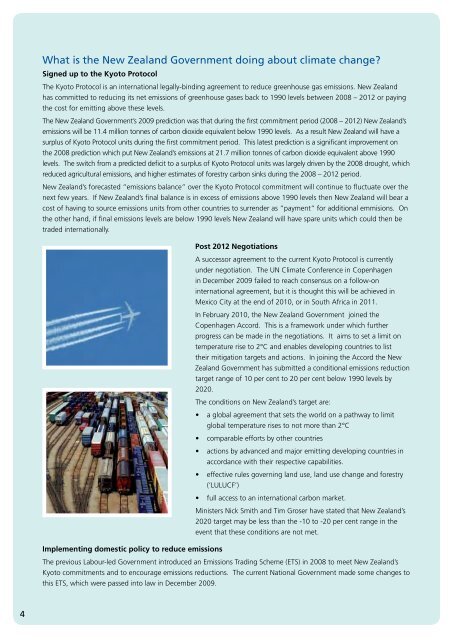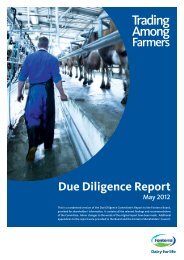A Fonterra Guide to Climate Change
A Fonterra Guide to Climate Change
A Fonterra Guide to Climate Change
- No tags were found...
Create successful ePaper yourself
Turn your PDF publications into a flip-book with our unique Google optimized e-Paper software.
What is the New Zealand Government doing about climate change?Signed up <strong>to</strong> the Kyo<strong>to</strong> Pro<strong>to</strong>colThe Kyo<strong>to</strong> Pro<strong>to</strong>col is an international legally-binding agreement <strong>to</strong> reduce greenhouse gas emissions. New Zealandhas committed <strong>to</strong> reducing its net emissions of greenhouse gases back <strong>to</strong> 1990 levels between 2008 – 2012 or payingthe cost for emitting above these levels.The New Zealand Government’s 2009 prediction was that during the first commitment period (2008 – 2012) New Zealand’semissions will be 11.4 million <strong>to</strong>nnes of carbon dioxide equivalent below 1990 levels. As a result New Zealand will have asurplus of Kyo<strong>to</strong> Pro<strong>to</strong>col units during the first commitment period. This latest prediction is a significant improvement onthe 2008 prediction which put New Zealand’s emissions at 21.7 million <strong>to</strong>nnes of carbon dioxide equivalent above 1990levels. The switch from a predicted deficit <strong>to</strong> a surplus of Kyo<strong>to</strong> Pro<strong>to</strong>col units was largely driven by the 2008 drought, whichreduced agricultural emissions, and higher estimates of forestry carbon sinks during the 2008 – 2012 period.New Zealand’s forecasted “emissions balance” over the Kyo<strong>to</strong> Pro<strong>to</strong>col commitment will continue <strong>to</strong> fluctuate over thenext few years. If New Zealand’s final balance is in excess of emissions above 1990 levels then New Zealand will bear acost of having <strong>to</strong> source emissions units from other countries <strong>to</strong> surrender as “payment“ for additional emmisions. Onthe other hand, if final emissions levels are below 1990 levels New Zealand will have spare units which could then betraded internationally.Post 2012 NegotiationsA successor agreement <strong>to</strong> the current Kyo<strong>to</strong> Pro<strong>to</strong>col is currentlyunder negotiation. The UN <strong>Climate</strong> Conference in Copenhagenin December 2009 failed <strong>to</strong> reach consensus on a follow-oninternational agreement, but it is thought this will be achieved inMexico City at the end of 2010, or in South Africa in 2011.In February 2010, the New Zealand Government joined theCopenhagen Accord. This is a framework under which furtherprogress can be made in the negotiations. It aims <strong>to</strong> set a limit ontemperature rise <strong>to</strong> 2°C and enables developing countries <strong>to</strong> listtheir mitigation targets and actions. In joining the Accord the NewZealand Government has submitted a conditional emissions reductiontarget range of 10 per cent <strong>to</strong> 20 per cent below 1990 levels by2020.The conditions on New Zealand’s target are:• a global agreement that sets the world on a pathway <strong>to</strong> limitglobal temperature rises <strong>to</strong> not more than 2°C• comparable efforts by other countries• actions by advanced and major emitting developing countries inaccordance with their respective capabilities.• effective rules governing land use, land use change and forestry(‘LULUCF’)• full access <strong>to</strong> an international carbon market.Ministers Nick Smith and Tim Groser have stated that New Zealand’s2020 target may be less than the -10 <strong>to</strong> -20 per cent range in theevent that these conditions are not met.Implementing domestic policy <strong>to</strong> reduce emissionsThe previous Labour-led Government introduced an Emissions Trading Scheme (ETS) in 2008 <strong>to</strong> meet New Zealand’sKyo<strong>to</strong> commitments and <strong>to</strong> encourage emissions reductions. The current National Government made some changes <strong>to</strong>this ETS, which were passed in<strong>to</strong> law in December 2009.4
















